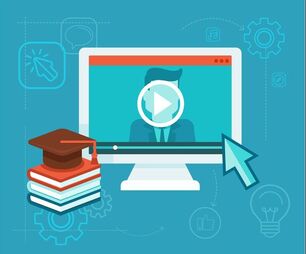Interactive Learning Environment
I took a class at Athens State University called Interactive Learning Environment. The focus of this class involved learning how to produce and facilitate high-quality synchronous online productions.
Synchronous, Asynchronous, and Hybrid Classes
E-learning can be divided into 3 categories:
- synchronous education
- asynchronous education
- hybrid education
Hybrid EducationHybrid learning is an individualized learning plan that is a combination between online, on campus, and/or at-home learning.
Hybrid classes are as much work, and sometimes more work, than traditional courses. Both meeting forms are used to teach and interact and are equally used and important in a hybrid or blended course. |
Asynchronous EducationAsynchronous learning does not take place in the same place or the same time. It is more self-guided and learning can be done in the student’s preferred time frame, when and where the student prefers. As long as requirements are met, the student will successfully complete the course.
Some methods of asynchronous online learning include self-guided lesson modules, streaming video content, virtual libraries, posted lecture notes, and exchanges across discussion boards or social media platforms. |
Tools for Synchronous Online Teaching
|
There are various types/categories of synchronous communication tools that can be used in an online course:
Text-Based Tools
|
Live Audio and Video Tools
Content, Display, and Other Interactive Tools
|
Webinars
A webinar is a live, virtual event that is executed online. Some challenges that should be addressed when preparing to facilitate a webinar are technical issues, clear instructions on how to access the webinar, distractions, engagement, etc. Anyone who facilitates a webinar needs to have some troubleshooting skills. Technical difficulties are common and a lot of the time the issue can be resolved with some simple troubleshooting. Some things to remember when conducting a webinar include:
Below I have a attached a PowerPoint that I created that I used in a webinar on how to bake perfect cupcakes.
- Ask your audience questions.
- Help the audience get involved.
- Practice, practice, practice!
- Grab and hold the audience’s attention.
- Maintain a conversational tone.
- Use interesting facts and examples.
- Remember your voice is the connection.
Below I have a attached a PowerPoint that I created that I used in a webinar on how to bake perfect cupcakes.
| how_to_bake_perfect_cupcakes.pptx | |
| File Size: | 9599 kb |
| File Type: | pptx |
Online Courses
Virtual classrooms are very useful. Virtual classrooms can be really useful for group projects. Students will be able to collaborate online, for example Google Slides. Students can work together without actually meeting face-to-face outside of the classroom, which takes away the stress of trying to find a time to meet that works for all members. When I was in high school, usually the only time a group could all meet was before school started, and even then sometimes a member or two would have sports practice before school which did not allow them to come. We could not meet after school due to sports and work. I would have really enjoyed having the opportunity to collaborate virtually. Virtual classrooms also allow students to access their work anytime, anywhere. This is helpful for students who miss school. It helps students to not fall behind.
Virtual class sessions generally have smaller audiences and more flexibility than a webinar. There are some ways to keep students’ interest during a virtual class session that are not as feasible with a webinar. There should be some type of engagement every 3-5 minutes in a virtual class session. This can be done with simple yes/no questions, asking for questions, or a brief group discussion. In virtual class sessions, the students interact more with one another than they do in a webinar. In a virtual class session, the teacher can break up students into groups and have them work together on something, then have them present to their peers.
Below I have included a PowerPoint that I created and used in an online course session on the life cycle of a butterfly.
Virtual class sessions generally have smaller audiences and more flexibility than a webinar. There are some ways to keep students’ interest during a virtual class session that are not as feasible with a webinar. There should be some type of engagement every 3-5 minutes in a virtual class session. This can be done with simple yes/no questions, asking for questions, or a brief group discussion. In virtual class sessions, the students interact more with one another than they do in a webinar. In a virtual class session, the teacher can break up students into groups and have them work together on something, then have them present to their peers.
Below I have included a PowerPoint that I created and used in an online course session on the life cycle of a butterfly.
| the_life_cycle_of_a_butterfly.pptx | |
| File Size: | 1719 kb |
| File Type: | pptx |





